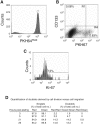Modeling the prostate stem cell niche: an evaluation of stem cell survival and expansion in vitro
- PMID: 20102283
- PMCID: PMC3158388
- DOI: 10.1089/scd.2009.0291
Modeling the prostate stem cell niche: an evaluation of stem cell survival and expansion in vitro
Abstract
The goal of this work was to engineer a clinically relevant in vitro model of human prostate stem cells (PSCs) that could be used to interrogate the mechanisms of stem cell control. We, therefore, compared the growth potential of stem cells in 3D culture (where the conditions would favor a quiescent state) with monolayer culture that has previously been demonstrated to induce PSC division. We found a fundamental difference between cultures of primary, adult PSCs grown as monolayers compared to those grown as spheres. The first supported the expansion and maintenance of PSCs from single cells while the latter did not. In an attempt to determine the mechanisms governing stem cell control, several known stem cell activators (including IFNalpha, FGF2, anti-TGFbeta, and dihydrotestosterone) were studied. However, cell division was not observed. CD133+ cells derived from a prostate cell line did not grow as spheres from single cells but did grow from aggregates. We conclude that PSCs can be expanded and maintained in monolayer culture from single cells, but that PSCs are growth quiescent when grown as spheres. It is likely that the physical arrangement of cells in monolayer provides an injury-type response, which can activate stem cells into cycle.
Figures







References
-
- Fuchs E, Tumbar T, Guasch G. Socialising with the Neighbors: stem cells and their niche. Cell. 2006;116:769–778. - PubMed
-
- Collins AT, Berry PA, Hyde C, Stower MJ, Maitland NJ. Prospective identification of tumorigenic prostate cancer stem cells. Cancer Res. 2005;65:10946–10951. - PubMed
-
- Birnie R, Bryce SD, Roome C, Dussupt V, Droop A, Lang SH, Berry PA, Hyde CF, Lewis JL, Stower MJ, Maitland MJ, Collins AC. Gene expression profiling of human prostate cancer stem cells reveals a pro-inflammatory phenotype and the importance of extracellular matrix interactions. Genome Biol. 2008;9:R83. - PMC - PubMed
-
- Collins AT, Habib FK, Maitland NJ, Neal DE. Identification and isolation of human prostate epithelial stem cells based on alpha(2)beta(1)-integrin expression. J Cell Sci. 2001;114(Pt 21):3865–3872. - PubMed
-
- Richardson GD, Robson CN, Lang SH, Neal DE, Maitland NJ, Collins AT. CD133, a novel marker for human prostatic epithelial stem cells. J Cell Sci. 2004;117(Pt 16):3539–3545. - PubMed
Publication types
MeSH terms
Substances
Grants and funding
LinkOut - more resources
Full Text Sources
Medical
Research Materials
